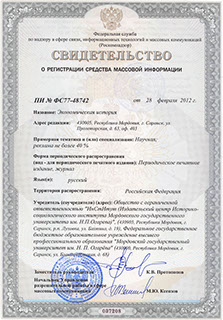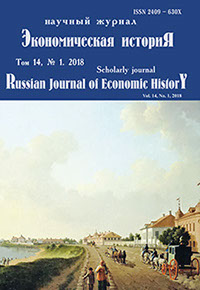Экономическая историЯ
Russian Journal of Economic History
ISSN 2409-630X (Print)
ISSN 2618-916X (Online)
Expert board:
- Scientific Council of RAS on economic history;
- Research and Educational Center «The economic history of Central Russia and the Middle Volga region» of Ogarev Mordovia State University;
- Center of Economic History of Lomonosov Moscow State University
Navigation
Certificate of registration

ISSN 2409-630X
DOI: 10.15507/2409-630X.040.014.201801.034-046
M. V. Kartashova
Balakhna Museum of History and Art Complex, Balakhna, Russia, e-mail: kmiw@mail.ru,
ORCID http://orcid.org/0000-0001-8878-9808
STATE SUPPORT OF HANDICRAFTS IN THE RUSSIAN EMPIRE IN THE LATE XIX – EARLY XX CENTURY: CREDITING OF HANDICRAFTSMEN
Introduction. The article examines the problems of lending handicraftsmen and artisan organizations in the late XIX – early XX centuries, during the period of industrial modernization of the country. The author tries to solve two problems: to analyze the discussions on the issues of granting loans to handicraftsmen and to study the process of granting loans. Materials and Methods. The work used a narrative method and a systematic approach. Individualizing comparisons were used in the individual provincial zemstvos in the study of problems of crediting artisans, general and specific credit lines in some provinces have been revealed. The statistical method has allowed to reveal the size of loans. Results. Consideration of the discussions that took place in government circles on the pages of periodicals made it possible to single out two types of lending for handicraftsmen: monetary and natural. The ways of crediting also elaborated: through specialized institutions: handicraft-industrial banks and small-ticket cash desks; through zemstvos; artisan warehouses organized by zemstvos, various societies and private individuals; through loan-savings and credit partnerships, created by the handicraftsmen. An analysis of archival materials allows us to state that the lending of handicraftsmen was financed by the government through the Department of Rural Economy and Agricultural Statistics of the Agricultural Department and through the zemstvos, cash offices of small loans became the most effective, they were opened at provincial and county zemstvos. Discussion. Most researchers are skeptical about tackling problems of lending to handicraftsmen by the zemstvos and the government. The peasants’ attitude to credit was an internal obstacle to more widespread adoption of the credit system in the Russian countryside. The peasants used the funds not for their intended purpose. Conclusion. The author comes to the conclusion that the problem of lending handicraftsmen was not solved by the beginning of the First World War. Only a handicraft and industrial credit cooperatives became popular. It needed time to peasants realized the profitability of obtaining loans. In general, the state policy of the Russian Empire aimed at the maintenance of crafts by lending can be considered sufficiently effective.
Keywords: Russian Empire, the state policy, the agricultural department, handicraft, handicraftsmen, crediting, credit cooperation, zemstvo.
For citation: Kartashova M. V. State Support of Handicrafts in the Russian Empire in the late XIX – early XX century: Crediting of Handicraftsmen. Ekonomicheskaya istoriya = Russian Journal of Economic History. 2018; 14(1): 34–46. (In Russ). DOI: 10.15507/2409-630X.040.014.201801.034-046
© Ogarev Mordovia State University. History and Sociology Institute, 2017
68, Of. 411, Bolshevistskaya St., 430005, The editorial office of the scholarly journal «Russian Journal of Economic History»
Tel.: (8342) 24-25-90; 27-07-11, Fax: (8342) 24-25-90, E-mail: jurnal-econom-hist@isi.mrsu.ru
Designed by A. Napalkov, Email: napalkov@isi.mrsu.ru

